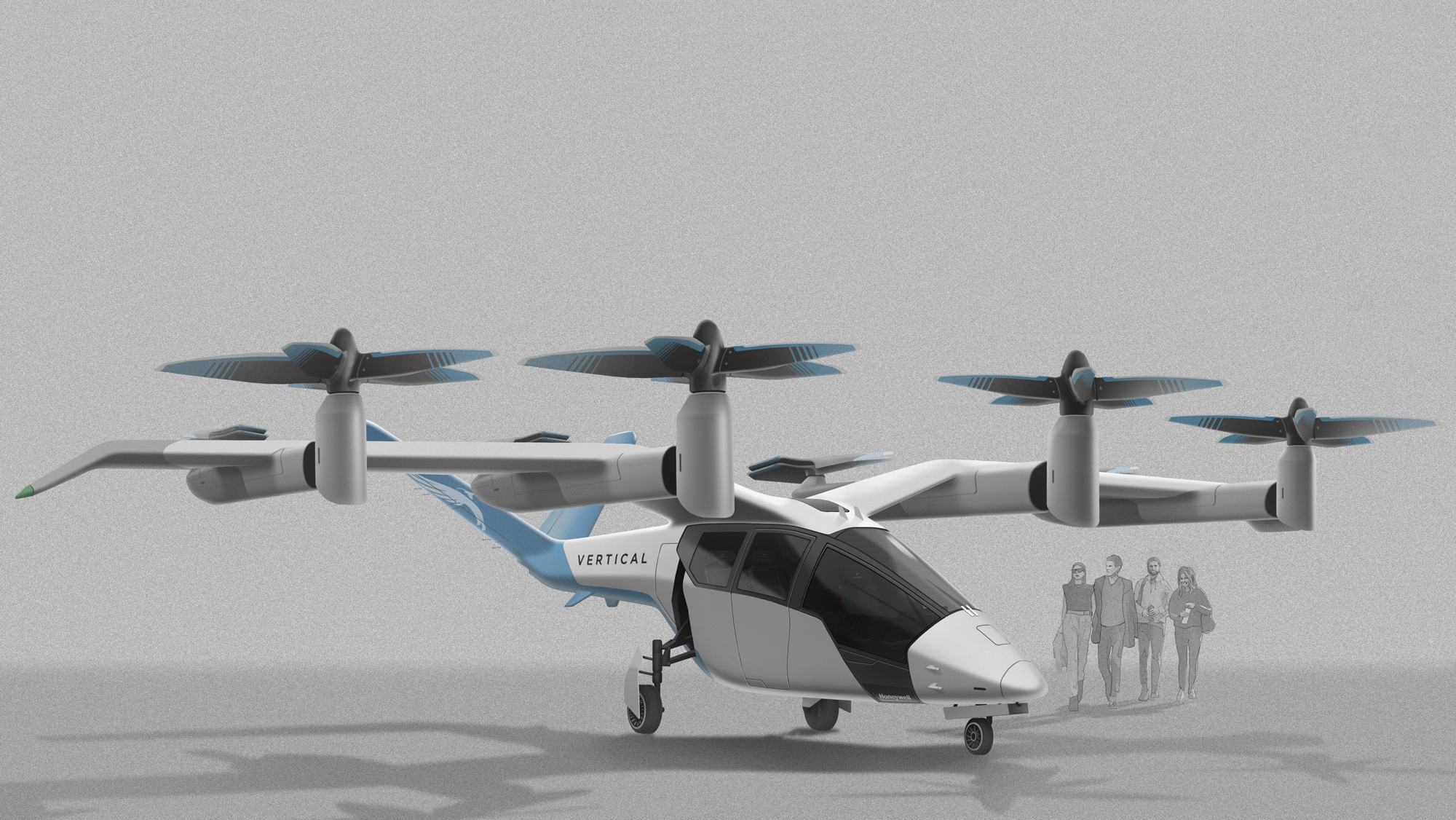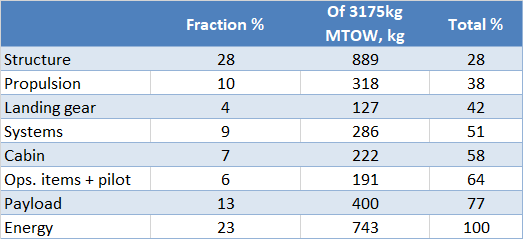Leeham News and Analysis
There's more to real news than a news release.
Bjorn’s Corner: Sustainable Air Transport. Part 42. eVTOL range.
October 21, 2022, ©. Leeham News: This is a summary of the article Part 42P, eVTOL range. It discusses the range of a typical eVTOL flying a feeder mission from a city center to an airport.
The 42P article details the energy consumption for each stage in the mission and the range we fly. We summarize the results here.

Figure 1. The Vertical Aerospace VX4 in an early rendering with similar looks to the eVTOL we discuss. Source: Vertical Aerospace.
How range is calculated for an eVTOL
eVTOLs, like all battery-based air vehicles, are severely energy constrained. You, therefore, calculate the range for such vehicles by first listing all the mandatory energy consumption areas. Then you calculate the vehicle range with the energy which is left.
First, we must understand how much energy we can fit into our eVTOL. We defined a mass fraction for energy in Part 39, Figure 2.
We have 743kg to spend on our battery system. If we assume that 700kg is available for battery modules (the rest is Battery management with cabling and liquid cooling system for the 56 modules), we end up with 144 kWh of battery energy for a system delivered in 2025 (energy density on the system level 206 Wh/kg).
We have defined that the battery system has been in use for a while and that a full charge achieves a 90% SOC (State of Charge). Our hover landing requires about 750kW of battery power, and the battery can only deliver such power levels when above 10% SOC.
It might be that the minimum SOC shall be higher for a battery at the end of its life as the internal resistance increases and the maximum current capability decreases. It requires a long-time test to establish which is beyond our scope for the articles. We assume a minimum of 10% SOC is OK.
We now have 114kWh of useful energy to spend on our mission (80% of 144kWh), Figure 2. Not all power can go to propulsion; we need power for all the eVTOL systems and passenger convenience. For our mission, 2.8kWh is blocked for such use.

Figure 2. The mission we fly with an optional alternate by bad weather at the destination. Source; Leeham Co.
Before you start mission calculations, you block off regulatory reserves, in our case 35.5 kWh for 20 minutes holding time in forward flight before transition.
We now have 76.8 kWh to use for our flying. Our vertical takeoff and transition take 6,5 kWh, followed by the climb 31KWh. We climb to 8,000ft, which gives a few nm longer range than if we climb to 5,000ft.
Our descent, approach, and vertical landing consume 20.8 kWh. It leaves 11.7kWh for the cruise, which is not a lot. Our total distance covered is 53 nm. It’s when we count all distances. As airports practice arrival and departure procedures, we should only count 50nm or less as a useful range.
How useful is a 50nm range?
It works to fly passengers from a city center to a closeby airport IF the weather is good. We have not introduced any margins for bad weather or flying in icing conditions, however.
It’s not useful for general air taxi services. It will seldom be that travel distances are below 50nm; in such cases, it’s faster to stay in the car and drive the distance. The city center to airport case has the city traffic speed as a motivator for the eVTOL services, the air taxi not.
In the next Corner, we will introduce more variables like non-ideal weather, normal landing instead of hover landing, etc., and see what happens.




Bjorn, fr.k’n 50NM. The sobering results of real world technology & requirements.
Still there’s tons of awesome videoclips, start-ups and visionaries, that will convince investors that breakthroughs, game changers and rapid evolving technology is there, to disrupt public transport moving forward.
While independents experts like Bjorn zip their tea, sigh, look out of the window.. Never let reality get in the way of great marketing campaign!
The (only) positive that I see, is that, bottom line, a lot of “dumb” capital is being invested in pushing energy technology, engineering, brains, that will benefit other future electrical applications and aeronautical developments.
50nm is almost 100km so it has a market in cities to airports especially with the airport on the other side of the river and massive traffic jams. In cities close to the ocean and high rise buildings interrupted with wide streets and rivers the wind conditions can cause quite bumpy rides in small UAM’s with sizeable wings. Hence they will pretty quick require advanced fly by wire systems, it might be easier with pure shorter range octacopters without wings giving rides like in a R22. Still I think it will be big business for FBW companies.
Interesting – I think you get quite a large increase in range for (relatively) small increase in battery density – if you can get the system battery to 250kWhr/kg, you end up with about 175kWhr battery (144 x 250/206), or 31kWhr more – that would take your cruise power from 12kWhr to 42kWhr or 3.5x
Given about half the total distance is cruise in your graph, or 25nm, that would boost the range to about 112.5miles.
Lets assume some other stuff goes up too, but 250kWhr/kg would probably double the range for a 21% increase in battery density. (I think)
The cruise distance is 8nm, so an increase to 250Wh/kg increases the range from 53nm to 70nm. Observe that the energy density with a battery you can build into your prototype for flights in 2023 has a system energy density of 167Wh/kg. I projected this can increase to 206Wh/kg by 2025-2028. We will probably have to wait until the end decade before we see 250Wh/kg battery system density.
The major problem is, this is for VFR conditions. IFR reserves will be the real problem, to discuss next week.
Fair enough – I took the graph as scale
Thank you
Cruise energy, not power.
Oops – my engineering professors would be horrified (but it was 35 years ago)
It gets worse. Batteries are not fuel (Rob McDonald posted nice series on topic shown ‘website’ box). Installation losses associated w/energy storage/use are likely to well exceed current onservative assumptions.
https://www.linkedin.com/in/rob-mcdonald-aerospace/recent-activity/posts/
register wall.
But: Interesting list:
https://scholar.google.com/citations?user=aU5asjcAAAAJ&hl=en
His electric stuff seems to be a bit older?
Rob’s ‘electric series’ is a 2022 synopsis that points out ‘big ticket’ items affecting battery installed performance – which is critical to achieving business value metrics (e.g., low operational cost, long range, large payload …). Likely worth signing up to read (linkedin). Additionally, there are numerous other books on topic found under AIAA (e.g., https://www.aiaa.org/events-learning/event/2021/08/11/default-calendar/EATS). Moral of story: NO FREE LUNCHES. “Ideal” performance is fine to estimate the ultimate performance (good for marketing, bad for engineering who have to produce it) – and thus falls under category “Ignorance is bliss”. Installed performance is critical we all know changes up-front are cheap, but waiting until production stage? Very, Very costly. https://media.cheggcdn.com/media/baf/bafab277-c570-47b0-a91d-12a40d99347d/phpoJ9mpK
“.. waiting until production stage? Very, Very costly.”
“Frederick Brooks:The Mythical man month”
at the time written with a view on Computer design & software.
Its scope has expanded to cover a much wider range of domains. (Would have been perfect reading for B.Management@787 🙂
This paper from MIT Technology Review comes to same conclusions for the winged types
https://www-technologyreview-com.cdn.ampproject.org/c/s/www.technologyreview.com/2022/08/17/1058013/electric-planes-taking-off-challenges/amp/
“That reserve requirement is ultimately the killer,” says Andreas Schafer, director of the air transportation systems lab at University College London.
‘When you take all that into account, the usable range of a 19-seat plane goes from about 160 miles to about 30 miles. For a larger aircraft like the 100-seat planes that Wright is building, it’s less than six miles. ”
Theres also the problem of using green energy to make green energy. You lose there as well
Massive, affordable, reliable green energy sources. They aren’t there & won’t be there for a long time, even we keep pushing billions into it. Just a detail I guess. https://ourworldindata.org/energy-mix
Don’t tell anyone, you don’t want to look like a naysayer, pessimist, bad for your career. Just -Like- everything.
Glad to live in Quebec where the electricity comes from only one suplier:Hydro-Quebec.